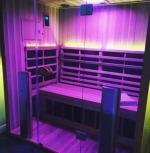Anodyne infrared therapy.
You may already have heard of anodyne infrared therapy in the context of healing wounds, sores, surgical wounds and even diabetic ulcers.
Rather than taking place in an infra red cabin, this treatment is applied by placing pads directly on the skin.
Infrared emitting diodes are fixed to flexible pads that can be applied in direct contact on the skin on any part of the body. The infrared energy causes molecules of nitric oxide to be released from hemoglobin in the bloodstream. Nitric oxide increases blood flow and helps deliver healing cells and nutrients to the treatment area.
This is an FDA-cleared therapy that has been successfully used many times to treat hard healing wounds and foot ulcers. Patient home use of this therapy in the US would be reimbursed under HCPCS Code E0221 - a durable medical equipment (DME) code.
But also over a thousand hospitals, nursing homes, home health agencies, universities, physician offices and therapy clinics offer anodyne infrared therapy as part of a comprehensive therapy program.
Just like the use of an infra red sauna, it :
- stimulates blood circulation
- brings pain reduction
Patients with diabetes often have impaired blood flow to the feet. Nerve damage (neuropathy) might result from this, causing a lack of sensation in the feet.
Symptoms are dry, cracking and easily peeling skin. Diabetes patients with impaired blood flow often suffer from foot ulcers and infections, which can be treated with anodyne infrared therapy.
The therapy is also commonly used for the treatment of tendonitis. This is a medical condition of inflammation of the tendons (where the muscles are attached to the bones). It causes a significant amount of pain.
Anodyne infrared therapy should not be used :
- directly over any active cancer
- near the womb of a pregnant woman
There are no known side effects, apart from :
- superficial burns - follow instructions carefully for treatment times
- hypoglycemia - always check your blood sugar whenever you start a new therapy with an increase in activity
It can be safely used with Metal implants, pins, screws and pacemakers.
From Anodyne Infrared Therapy to more health benefits
Copyright Infrared Sauna Reference

New! Comments
Have your say about what you just read! Leave me a comment in the box below.